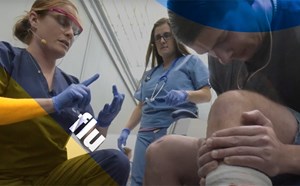
EM-onomics: ACEP EMDI Economic Registry
"Go where the money is... and go there often." ~ Willie Sutton, (Successful Bank Robber)
For years, it has been well documented that there are significant variations in clinical practice and costs of emergency medicine (EM). Further, there’s little consistency in reimbursement rates regionally or even in the same hospital among different payers. How this impacts EM specifically is poorly understood, as is the impact of uncompensated care. ACEP is proposing a new economic registry to “go where the money is … and go there often”- in the words of Willy Sutton to take control of the future of EM reimbursement.
Comprehensive data on spending patterns and collections for emergency medicine does not exist. As it stands, EM reimbursement is largely based on fee for service reimbursement with MIPS/MACRA quality incentives. In the future, as reimbursement transitions to more value-based payments, it will be crucial for EM to be able to show what value it’s achieving for the healthcare dollar. ACEP is participating in a program called MIPS value pathways that started this year, highlighting the importance of preparing for changes in reimbursement incentives. This is even more crucial as EM becomes a larger proportion of aggregate health spending.1
The proposed economic registry is intended to track specific EM utilization patterns and reimbursement data with the potential to improve quality, efficiency, and value. To achieve a robust data pool, we will have to establish a protocol for interoperability between data sets and integrate with existing EM Data platforms like EMDI and CEDR. If the data set is dynamic enough, the registry should be able to support financial planning for individual emergency departments.
Emergency medicine should control its own fate regarding data, reimbursement, and quality initiatives. Owning the data pertaining to cost and quality is essential to achieving this outcome. Robust and transparent data sets concerning reimbursement for services (variability by region, variability by payer) and number of services rendered (variability by region, distinguishing between physicians and mid-levels) are a necessary part of this process. Data will help demonstrate the high value, cost efficiency, and quality of emergency medicine.
If we can better understand utilization patterns and cost, then we should be able to identify high value clinical approaches and enhance development and implementation of evidence-based medicine. We hope to quantify the financial burden of uncompensated care and facilitate fair reimbursement. We should also be better able to guide lawmakers as they change incentives in healthcare reimbursement.
Achieving our goals will require collaboration between ACEP, revenue cycle management companies, and several outside organizations. If this can be achieved, the registry platform could even be extended to other medical specialties, as it enables EM and ACEP to thrive in the healthcare environment of tomorrow.
Footnotes
- The percentage of U.S. health spending attributable to the emergency department has increased from 3.9% (CI, 3.9%-3.9%) in 2006 to 5.0% (CI, 5.0%-5.0%) in 2016. According to The Centers for Medicare & Medicaid Services, 55% of an emergency physician's time is spent providing uncompensated care. Other studies have indicated that $42.67 billion in hospital based uncompensated care was provided in 2020.
Author(s)

Nathan Vafaie, MD, MBA
EMDI Economic Registry Physician Lead
 American College of Emergency Physicians
American College of Emergency Physicians

